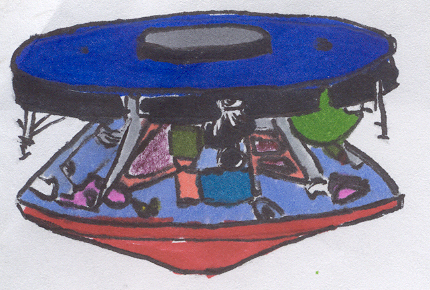Distance: The moon is a total of 238,857 miles away from Earth. If we travel most of the distance at 12,000 mph, the rover will arrive at the Moon in 20 hours. [17]

Even though designing a launch vehicle isn't our main focus point for this competition, it is still a major part of the X-Prize and we have decided to place in on our website regardlessly. X-Prize teams must design an affordable, and efficient Launch Vehicle to take a rover into space. The rocket of the launch vehicle must be powerful enough to escape the gravity of the Earth and send a rover on it's path to the Moon. Once there, the rover must be capable of autonomously slowing down from speeds of around 12,000 mph and landing on the moon without being damaged.
The Launch Vehicle for our rover will have three stages.
Stage 1: The first stage is made up of an engine, fuel and oxidizer tanks, and a section for electronic equipment. The engine burns kerosene and liquid oxygen, which are separated until shortly before liftoff, and propel the Launch Vehicle off the launch pad. Once in the air, a pump continuously pushes more and more kerosene and liquid oxygen into the combustion chamber to accelerate the rocket. Along with the main liquid propellant rocket, there are 9 strap-on solid propellant rockets made of hydroxyl-terminated polybutadiene fuel and a light-weight graphite-epoxy shell. These rockets produce additional thrust and help accelerate the 600 thousand pound Launch Vehicle miles into the sky and into closer to space. [6]| Payload Fairing: The spacecraft (in which the rover is housed) and upper two stages are kept in the payload fairing. The fairing protects the equipment from the elements and makes the rocket more aerodynamic. After protecting the payload from the tremendous pressure of lift off, the fairing is jettisoned after the ignition of the second stage.[6] Distance: The moon is a total of 238,857 miles away from Earth. If we travel most of the distance at 12,000 mph, the rover will arrive at the Moon in 20 hours. [17] |
 |